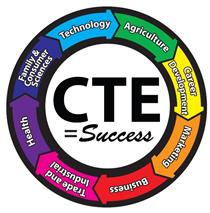Search
Secondary CTE
Career & Technical Education (CTE) Works for Middle & High School Students!
Leon Students Get Certified
Why Career & Technical Education?
In order for students to succeed, we need to prepare them for the ever-changing world of work, which means not only college readiness, but career readiness—students with access to postsecondary education and skills attainment possibilities that will prepare them to achieve in the 21st century.
We ask the question, “Why Career and Technical Education?” with honesty. Why, among the many competing education demands, student needs, and graduation requirements, does a program that has its foundations in the 1917 Smith-Hughes Act hold relevancy still? Between emphases on early learning to college preparation, where does Career and Technical Education (CTE) fit in and merit consideration? Why should students who barely have an opportunity to explore the arts, health and fitness, or social studies, be directed to courses in aerospace manufacturing, horticulture, financial math, sports medicine, or integrated science, technology, engineering, and mathematics (STEM)?
The answer to the above questions, we believe, is that CTE offers a unique opportunity to engage students in an enormous variety of subjects, incorporating academic, creative and technical skills, with the specific goal, nowhere else represented in education, of preparing students for all of life that comes after high school.
CTE needs to be an integral part of every student’s education so that all students graduate from high school globally competitive for work, prepared for postsecondary education, and ready for life as positive, contributing members of society in the 21st century. With CTE, students succeed.
Exploring the Paths to Your Future
Every Career and Technical Education class falls into one of 17 “career clusters.” A career cluster is a group of jobs and industries that are related by skills or products. Within each cluster, there are cluster “pathways” that correspond to a collection of courses and training opportunities to prepare you for a given career.
The 17 clusters were established at the national level by the States’ Career Clusters Initiative and are recognizable across the United States in middle schools, high schools, community and technical colleges, and the workforce.
Each cluster has a page on this Web site and each contains information on careers, affiliated student leadership organizations, education and training options for high school graduates after high school, and other related student resources.
-
- Agriculture, Food & Natural Resources
- Architecture & Construction
- Arts, A/V Technology & Communications
- Business, Management & Administration
- Education & Training
- Energy
- Engineering & Technology Education
- Finance
- Government & Public Administration
- Health Science
- Hospitality & Tourism
- Human Services
- Information Technology
- Law, Public Safety, Corrections & Security
- Manufacturing
- Marketing, Sales & Services
- Transportation, Distribution & Logistics
- Additional CTE Programs/Courses
Frameworks
There are many CTE courses offered under each career cluster. More than a syllabus or other course outline, a framework is a guide and a tool that aligns National and Industry Standards to State Core Content Standards, Performance Assessments, Leadership, Employability, Relevance to Work and Thinking Skills all in one document. Frameworks provide an overview of the outcomes that students meet in the CTE course.
Frameworks help ensure student outcomes are relevant to the current needs of their program of study’s industry and national standards. Frameworks support the continuous improvement of CTE programs because they are reviewed annually by program advisory committees and by program specialist at the Florida Department of Education.
Secondary Programs
Chiles High School
- Communications Technology (8601000)
- Criminal Justice Operations (8918000)
- Culinary Arts (8800500)
- Digital Media/Multimedia Design (8201200)
- Web Development (9001100)
Godby High School
- Aerospace Technologies (8600080)
- Agritechnology (8106800)
- Digital Design (8209600)
- Digital Media/Multimedia Design (8201200)
- Engineering Pathways (9400300)
- Web Development (9001100)
- Welding Technology Fundamentals (9204400)
Leon High School
- Business Management and Analysis (8301100)
- Building Trades & Construction Design Technology (8722000)
- Culinary Arts (8800500)Building Construction Technologies (8720300)
- Digital Design (8209600)
Lincoln High School
- Business Management and Analysis (8301100)
- Culinary Arts (8800500)
- Digital Design (8209600)
- Early Childhood Education (E300100)
- Horticulture Science and Services (8121600)
- Web Development (9001100)\
Rickards High School
SAIL High School
- Digital Design (8209600)
- Agritechnology (8106800)
- Engineering Pathways (9400300)
- Journalism and Multimedia (8771101)
- Digital Photography Technology (8201300)
DCT and OJT Resources
DOE On-the-Job Training Frequently Asked Questions
DOE Cooperative Education OJT Manual
Student Guide
Teacher Guide
General Reminders
DCT and OJT Forms
Training Agreement
Training Plan
Time Card
